Old emergency vehicles are a bit of a niche market as far as classic vehicles go, but everyone can appreciate an old ambulance like this ’55 Ford Courier sedan-delivery that was coachbuilt by National back in the day. It just so happens to be up for sale here on craigslist in Salem, Oregon. Let’s look closer! Thank-you to reader MattR for letting us know about it!
The first civilian ambulance services allegedly date back to 1865 with Commercial Hospital (Now Cincinnati General) in Ohio. Prior to WWII, ambulance services were mostly run by local funeral homes, purely for transport of ill or injured persons to a hospital. The people driving and attending had little first-aid training, but then, first-aid as we know it was not widespread nor required everywhere, and medical equipment technology was rather rudimentary. After the war, dedicated ambulance and rescue services began to emerge, and the post-war Civil Defense initiatives helped to motivate communities large and small to begin to get their stuff together when it came to emergency services.
Specific to this car, we weren’t able to find a lot on this specific coachbuilder on a short deadline, but the Shop Of Siebert kept coming up as associated with National. Siebert apparently did their thing from 1853 to sometime in the early 1960s, creating all kinds of specialty, custom units, eventually settling on station-wagon bodies that didn’t need major exterior changes to get the job done.
The car we see today looks to be in very nice original shape, and the seller tells us that it is unrestored, save for some floorpan repairs. It apparently has the Y-Block 272-ci V8, Borg Warner 3-speed gearbox and Dana rear, having traveled only 55,000 miles or so. We are also told that it retains all of its functional emergency lights and siren, under-floor storage, and swiveling front seats.
To me personally, old emergency equipment is my most favorite type of classics. Police cars, ambulances, and fire apparatus are right up my alley, and I had the honor of meeting a founding member of the Professional Car Society a few years ago. I myself rescued and re-homed an ’86 Gran Fury police package, and was more than a little bummed when I realized that I couldn’t afford to keep and fix it properly. I think this Ford is in great shape, really neat, and I want to have something like it someday.
That’s my take on it, what’s yours? Let us know!







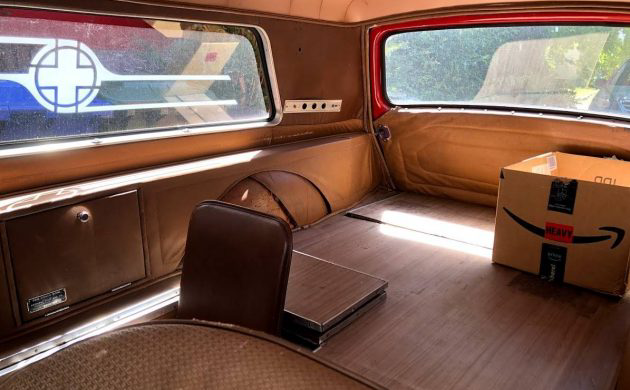
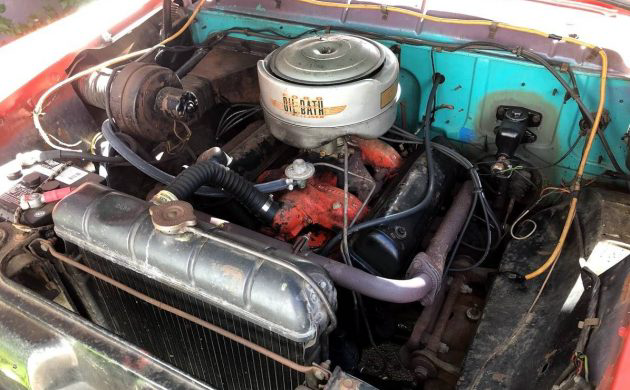
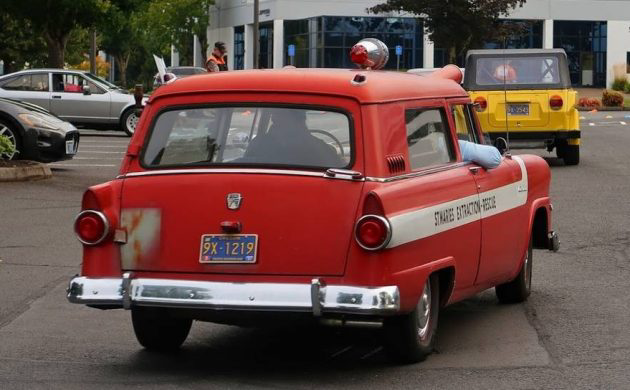
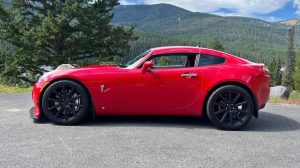


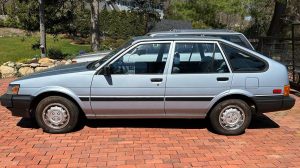


Think of the horrors this vehicle saw, when it was merely a transport, survival was iffy. I remember, before paramedics and ambulances were one, the medical folks showed up in a different vehicle, the ambulance was just for transport. In Milwaukee, the meds showed up in a red van, kind of like “Emergency” on TV, and the police had Travelalls, then Suburbans( the old man bought an ex-Milwaukee police Suburban) to haul you in, after a quick stop at Winchells donuts first. As a truck driver, I’ve seen plenty of ambulances in action, many in no hurry leaving the scene, if you know what I mean, so naturally, any ambulance creeps me out. It is in such nice shape, one would hate to ruin it’s appearance. It is a cool find.
With that under hood shot, I see the firewall and underside of the hood are Sea Sprite Green (I think that is the official name).
Would the conversion company buy what they could find and then paint to order, rather than place a special order color and than play the waiting game?
Yes. Whether it was National or Siebert, it was a smaller coachbuilder and they very well could have bought the base of the conversion right out of dealer stock.
Howard, Milwaukee’s first purpose built ambulance was a 1947 Cadillac, I forget who the coachbuilder was. It still exists. There is an old, decommissioned firehouse on 16th & Oklahoma that is now a fire department run museum. That ambulance, which had been operated by the fire department and stationed at the down town department, is now in that museum. It had previously been owned by my now deceased former boss at the hearse dealership. He owned it before I knew him, and I never seen the vehicle myself except in pictures. Although the museum is open to the public, hours are limited so I have never been to it.
I am going to do some research & see if I can figure out which coach builder built it, but I will guess Siebert.
Ok, I had a book written by a cat named Thomas McPherson. It was basically the bible of hearse & ambulance history dating back to 1900. I can’t find where it went. Too many people in my house who don’t understand boundaries (I can’t wait to see what all is missing once I am released from my upcoming sentence lol).
So I googled the name Siebrrt coachbuilders. It appears that I was half right. National was Siebert’s distributor. I thought National built their own coaches too, and they might have. I didn’t check into that before I started this.
Anyhow, I am almost positive this is a Siebert because of those side windows. I got it in my head that those are Siebert all the way.
Now I gotta tear up my house and find this book. Ebay has them for $50.00 & up! I don’t want to spend that if I already own it lol.
Steve, I had that book too, but I can’t find mine either.
I remember National building on Chevy chassis and Siebert putting out the Ford versions.
Yes! You got it right. I was in the ballpark when you got the home run lol.
Thank you Miguel!
Gotta love seller’s statement ‘not a ride for the introverted’ …! Now this is a cool find indeed, ambulances were all coachbuilt meaning production #s are miniscule.
Mostly ambulance conversions were built on specific longer WB chassis, which makes this one unusual being a standard WB. Another company manufacturing standard WB ambulances was Automotive Conversion Corp offering the Amblewagon conversion at $1.000 for Ford, Edsel and Mercury wagons, but plenty other brands were also converted. The Amblewagon was initially constructed with utility in mind, meaning its ambulance-specific interior could be removed to convert it back to regular wagon (less the rear door) in minutes. Haul corpses one day, furniture the next day and your family to church on Sunday…!
As a long time collector of Ambulances, Hearses, & Limousines, I was an early member of the Professional Car Society. National & Siebert were just 2 of many US and Canadian conversion companies that created hearses and ambulances for those with a lower budget.
Many were built for small towns, but when it came to creating a vehicle on a standard length wheelbase using a station wagon or panel delivery [like this one], they were destined for larger manufacturing companies who wanted an in-house ambulance for their medical emergency department.
With the words “Extraction – Rescue” on the side of the car, I suspect this was possibly owned by a mine company, as the act of rescuing guys from a mine explosion or cave-in was typically known as an extraction.
Many companies who bought these vehicles often brought a vehicle they had already purchased to companies like Siebert, or Siebert simply found a good deal on an existing vehicle at a Ford Dealer that met their requirements. That’s likely the reason for the paint color on the firewall.
I hope the new owner keeps it just as it is.
In a ambulance you gotta chance. In a hearse its gotta be worse.
In the words of Mr. Dead, a hearse is a hearse, of curse of curse.
My theory is people die in ambulances. Creepy. Hearses? Very rarely do they die in them. A hearse just hauls meat, kinda like bringing home steak in the trunk of your car from the grocery store.
Steve, a hearse was made to move a box from one place to another. What is in the box really doesn’t matter.
I can see things getting messy in an ambulance, but never in a hearse, unless they put the flowers in there.
Exactly my point Miguel lol.
You have no idea how many times I had to explain that to small brained people.
Me too buddy lol.
The book you’re referring to is “American Funeral Cars and Ambulances since 1900”, part of the Crestline series of automotive (and agricultural) encyclopedias. I’ve had my copy for 40+ years, have almost worn it out. I’m at work, using memory so please excuse any misstatements. National was based in Knightstown, Indiana which must have been a hotbed of coach building firms as several professional cars came out of that area. Siebert was based in Ohio and as far as I know wasn’t directly affiliated with National. They may have shared dealers, I don’t know. Siebert specialized in Ford vehicles and National stayed mainly with Chevrolet although they also used Pontiac. Both Siebert and National produced lower priced professional vehicles.
The pictured National hearse is one I bought many years ago, had been retired from Funeral duties and was an ambulance at a small dirt track in western Minnesota. The track closed I think in the early ’70s, the hearse, a water truck and a Falcon 2 Dr wagon had been left out in the weeds for years. I dragged the hearse to my barn where is has been (at least inside) for 20+ years.
Almost forgot, behind what was left of the stands was a very early Caterpiller road grader ( motor patrol) with a 4 cylinder gas engine and a wooden cab. I tried buying it also, not sure why but it was cool, but the son of the deceased track owner didn’t want to sell. I drove by the site a few years ago and everything is gone, even the track had been leveled for growing crops.
Thank you 427 for clarification. Google isn’t always that accurate lol.
Yeah, most of the coachbuilders are still based in Indiana. I never knew why, but I made many trips to Indiana when I worked for the hearse dealer.
That is a neat old hearse you got there too! I would love to see that back on the road.
427, I read that hearse book cover to cover and the only error I found in the description was the one for the car I owned. It was a 1963 Cadillac Eureka Landau. there is a double word there, if I remember correctly, that should not have been there.
If you find your book look it up.
Looks like an interesting barn :) Lucky you. Is that a ’41 Chevy truck behind it?
That is a 46 grain truck. Above is a 41 1 1/2 ton cab. Nice sheet metal, original paint. Salvage yard owner wanted the rear of the frame so he cut it right behind the cab. Too many projects, am beginning to thin things out. Upon retirement (1-2 years) will really start pursuing cleaning out the barns.
That one needs to be, pardon me, “resurrected” 427Turbojet! Looks like a stretched wheelbase on a deluxe model Chevy.
National mainly used stretched sedan delivery bodies. That’s one thing that really attracted me to this hearse, I like the proportions of the lower (stock) rooflines. This one sat outside with broken windows for many years, the back side doors are wood framed and I’m afraid if I open them it’ll be very difficult to close them. Still, I couldn’t just leave it there to rot into the ground.
I was, back in the day the Police Dept’s ran the ambulances, called them “throw n’ go”, as had little medical knowledge. But did deliver 3 babies in 21 yr’s. Had a
55 Caddy that got totaled in 61, then the City got us Ambulets, Studebaker’s, sort of worked. I got hit by a car and went to the hospital in one, had to leave the tailgate glass up as I hung out. then got q 69 chevy Divco-Wayne ambulance, great vehicle, it got broaddsided by a cycle, the rider went right thru the side windows
the tin worms got it also
This is a really cool car that seems original to the coach building work!! All of you guy always remind me of why I’m on this site!! The years of car knowledge is unprecedented by far to any other site I wander through!! Thank you!! You all deserve a pat on the back for your willingness to share you knowledge and insight!!!!!
https://www.hagerty.com/media/buying-and-selling/this-1955-ford-courier-national-ambulette-is-not-for-the-introverted/
Nice write up on it.
@ keith.well at least they credited BF! I’m curious about the turquoise color on the firewall…….maybe a turquoise car when bought for the conversion.?
I’d be happy to drive this around. There is a guy in San Diego county who has a 55 Ford wagon painted white. Its fitted with all manner of rescue equipment and hes basically
a good samaritan of the hiways.
https://www.sandiegouniontribune.com/opinion/the-conversation/sdut-san-diego-highwayman-2015jan30-htmlstory.html
National was located in Knightstown Indiana. I believe there were three different coach builders in Knightstown at one time. The movie Hoosiers was filmed in the local gym and is a tourist destination.